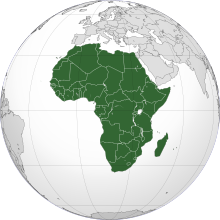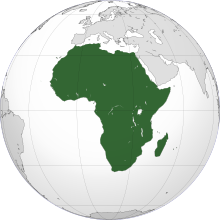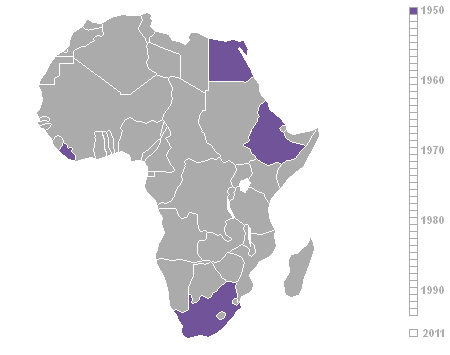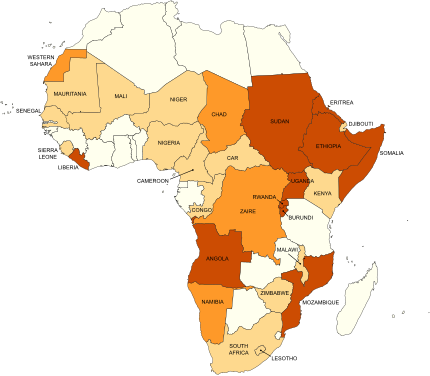A | B | C | D | E | F | G | H | CH | I | J | K | L | M | N | O | P | Q | R | S | T | U | V | W | X | Y | Z | 0 | 1 | 2 | 3 | 4 | 5 | 6 | 7 | 8 | 9
| Area | 30,370,000 km2 (11,730,000 sq mi) (2nd) |
|---|---|
| Population | 1,393,676,444[1][2] (2021; 2nd) |
| Population density | 46.1/km2 (119.4/sq mi) (2021) |
| GDP (PPP) | $8.05 trillion (2022 est; 4th)[3] |
| GDP (nominal) | $2.96 trillion (2022 est; 5th)[4] |
| GDP per capita | $2,180 (Nominal; 2022 est; 6th)[5] |
| Religions |
|
| Demonym | African |
| Countries | 54+2*+4** (*disputed) (**territories) |
| Dependencies | External (4) Internal (6+1 disputed)
|
| Languages | 1250–3000 native languages |
| Time zones | UTC-1 to UTC+4 |
| Largest cities | Largest urban areas: |

Africa is the world's second-largest and second-most populous continent, after Asia in both aspects. At about 30.3 million km2 (11.7 million square miles) including adjacent islands, it covers 20% of Earth's land area and 6% of its total surface area.[7] With 1.4 billion people[1][2] as of 2021, it accounts for about 18% of the world's human population. Africa's population is the youngest amongst all the continents;[8][9] the median age in 2012 was 19.7, when the worldwide median age was 30.4.[10] Despite a wide range of natural resources, Africa is the least wealthy continent per capita and second-least wealthy by total wealth, ahead of Oceania. Scholars have attributed this to different factors including geography, climate, tribalism,[11] colonialism, the Cold War,[12][13] neocolonialism, lack of democracy, and corruption.[11] Despite this low concentration of wealth, recent economic expansion and the large and young population make Africa an important economic market in the broader global context.
The continent is surrounded by the Mediterranean Sea to the north, the Isthmus of Suez and the Red Sea to the northeast, the Indian Ocean to the southeast and the Atlantic Ocean to the west. The continent includes Madagascar and various archipelagos. It contains 54 fully recognised sovereign states, eight cities and islands that are part of non-African states, and two de facto independent states with limited or no recognition. This count does not include Malta and Sicily, which are geologically part of the African continent. Algeria is Africa's largest country by area, and Nigeria is its largest by population. African nations cooperate through the establishment of the African Union, which is headquartered in Addis Ababa.
Africa straddles the equator and the prime meridian. It is the only continent to stretch from the northern temperate to the southern temperate zones.[14] The majority of the continent and its countries are in the Northern Hemisphere, with a substantial portion and a number of countries in the Southern Hemisphere. Most of the continent lies in the tropics, except for a large part of Western Sahara, Algeria, Libya and Egypt, the northern tip of Mauritania, and the entire territories of Morocco, Ceuta, Melilla, and Tunisia which in turn are located above the tropic of Cancer, in the northern temperate zone. In the other extreme of the continent, southern Namibia, southern Botswana, great parts of South Africa, the entire territories of Lesotho and Eswatini and the southern tips of Mozambique and Madagascar are located below the tropic of Capricorn, in the southern temperate zone.
Africa is highly biodiverse;[15] it is the continent with the largest number of megafauna species, as it was least affected by the extinction of the Pleistocene megafauna. However, Africa also is heavily affected by a wide range of environmental issues, including desertification, deforestation, water scarcity and pollution. These entrenched environmental concerns are expected to worsen as climate change impacts Africa. The UN Intergovernmental Panel on Climate Change has identified Africa as the continent most vulnerable to climate change.[16][17]
The history of Africa is long, complex, and has often been under-appreciated by the global historical community.[18] Africa, particularly Eastern Africa, is widely accepted as the place of origin of humans and the Hominidae clade (great apes). The earliest hominids and their ancestors have been dated to around 7 million years ago, including Sahelanthropus tchadensis, Australopithecus africanus, A. afarensis, Homo erectus, H. habilis and H. ergaster—the earliest Homo sapiens (modern human) remains, found in Ethiopia, South Africa, and Morocco, date to circa 233,000, 259,000, and 300,000 years ago, respectively, and Homo sapiens is believed to have originated in Africa around 350,000–260,000 years ago.[a] Africa is also considered by anthropologists to be the most genetically diverse continent as a result of being the longest inhabited.[25][26][27]
Early human civilizations, such as Ancient Egypt and Carthage emerged in North Africa. Following a subsequent long and complex history of civilizations, migration and trade, Africa hosts a large diversity of ethnicities, cultures and languages. The last 400 years have witnessed an increasing European influence on the continent. Starting in the 16th century, this was driven by trade, including the Trans-Atlantic slave trade, which created large African diaspora populations in the Americas. From the late 19th century to the early 20th century, European nations colonized almost all of Africa, reaching a point when only Ethiopia and Liberia were independent polities.[28] Most present states in Africa emerged from a process of decolonisation following World War II.
Etymology

Afri was a Latin name used to refer to the inhabitants of then-known northern Africa to the west of the Nile river, and in its widest sense referred to all lands south of the Mediterranean (Ancient Libya).[29][30] This name seems to have originally referred to a native Libyan tribe, an ancestor of modern Berbers; see Terence for discussion. The name had usually been connected with the Phoenician word ʿafar meaning "dust",[31] but a 1981 hypothesis[32] has asserted that it stems from the Berber word ifri (plural ifran) meaning "cave", in reference to cave dwellers.[33] The same word[33] may be found in the name of the Banu Ifran from Algeria and Tripolitania, a Berber tribe originally from Yafran (also known as Ifrane) in northwestern Libya,[34] as well as the city of Ifrane in Morocco.
Under Roman rule, Carthage became the capital of the province it then named Africa Proconsularis, following its defeat of the Carthaginians in the Third Punic War in 146 BC, which also included the coastal part of modern Libya.[35] The Latin suffix -ica can sometimes be used to denote a land (e.g., in Celtica from Celtae, as used by Julius Caesar). The later Muslim region of Ifriqiya, following its conquest of the Byzantine (Eastern Roman) Empire's Exarchatus Africae, also preserved a form of the name.
According to the Romans, Africa lies to the west of Egypt, while "Asia" was used to refer to Anatolia and lands to the east. A definite line was drawn between the two continents by the geographer Ptolemy (85–165 CE), indicating Alexandria along the Prime Meridian and making the isthmus of Suez and the Red Sea the boundary between Asia and Africa. As Europeans came to understand the real extent of the continent, the idea of "Africa" expanded with their knowledge.
Other etymological hypotheses have been postulated for the ancient name "Africa":
- The 1st-century Jewish historian Flavius Josephus (Ant. 1.15) asserted that it was named for Epher, grandson of Abraham according to Gen. 25:4, whose descendants, he claimed, had invaded Libya.
- Isidore of Seville in his 7th-century Etymologiae XIV.5.2. suggests "Africa comes from the Latin aprica, meaning "sunny".
- Massey, in 1881, stated that Africa is derived from the Egyptian af-rui-ka, meaning "to turn toward the opening of the Ka." The Ka is the energetic double of every person and the "opening of the Ka" refers to a womb or birthplace. Africa would be, for the Egyptians, "the birthplace."[36]
- Michèle Fruyt in 1976 proposed[37] linking the Latin word with africus "south wind", which would be of Umbrian origin and mean originally "rainy wind".
- Robert R. Stieglitz of Rutgers University in 1984 proposed: "The name Africa, derived from the Latin *Aphir-ic-a, is cognate to Hebrew Ophir ."[38]
- Ibn Khallikan and some other historians claim that the name of Africa came from a Himyarite king called Afrikin ibn Kais ibn Saifi also called "Afrikus son of Abraham" who subdued Ifriqiya.[39][40][41]
- Arabic afrīqā (feminine noun) and ifrīqiyā, now usually pronounced afrīqiyā (feminine) 'Africa', from ‘afara 'to be dusty' from ‘afar 'dust, powder' and ‘afir 'dried, dried up by the sun, withered' and ‘affara 'to dry in the sun on hot sand' or 'to sprinkle with dust'.[42]
- Possibly Phoenician faraqa in the sense of 'colony, separation'.[43]
History
Prehistory

Africa is considered by most paleoanthropologists to be the oldest inhabited territory on Earth, with the Human species originating from the continent.[44] During the mid-20th century, anthropologists discovered many fossils and evidence of human occupation perhaps as early as seven million years ago (Before present, BP). Fossil remains of several species of early apelike humans thought to have evolved into modern humans, such as Australopithecus afarensis radiometrically dated to approximately 3.9–3.0 million years BP,[45] Paranthropus boisei (c. 2.3–1.4 million years BP)[46] and Homo ergaster (c. 1.9 million–600,000 years BP) have been discovered.[7]
After the evolution of Homo sapiens approximately 350,000 to 260,000 years BP in Africa,[20][21][22][23] the continent was mainly populated by groups of hunter-gatherers.[47][48] These first modern humans left Africa and populated the rest of the globe during the Out of Africa II migration dated to approximately 50,000 years BP, exiting the continent either across Bab-el-Mandeb over the Red Sea,[49][50] the Strait of Gibraltar in Morocco,[51][52] or the Isthmus of Suez in Egypt.[53]
Other migrations of modern humans within the African continent have been dated to that time, with evidence of early human settlement found in Southern Africa, Southeast Africa, North Africa, and the Sahara.[54]
Emergence of civilization
The size of the Sahara has historically been extremely variable, with its area rapidly fluctuating and at times disappearing depending on global climatic conditions.[55] At the end of the Ice ages, estimated to have been around 10,500 BCE, the Sahara had again become a green fertile valley, and its African populations returned from the interior and coastal highlands in sub-Saharan Africa, with rock art paintings depicting a fertile Sahara and large populations discovered in Tassili n'Ajjer dating back perhaps 10 millennia.[56] However, the warming and drying climate meant that by 5000 BC, the Sahara region was becoming increasingly dry and hostile. Around 3500 BC, due to a tilt in the Earth's orbit, the Sahara experienced a period of rapid desertification.[57] The population trekked out of the Sahara region towards the Nile Valley below the Second Cataract where they made permanent or semi-permanent settlements. A major climatic recession occurred, lessening the heavy and persistent rains in Central and Eastern Africa. Since this time, dry conditions have prevailed in Eastern Africa and, increasingly during the last 200 years, in Ethiopia.
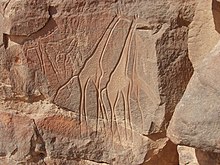
The domestication of cattle in Africa preceded agriculture and seems to have existed alongside hunter-gatherer cultures. It is speculated that by 6000 BC, cattle were domesticated in North Africa.[58] In the Sahara-Nile complex, people domesticated many animals, including the donkey and a small screw-horned goat which was common from Algeria to Nubia.
Between 10,000 and 9,000 BC, pottery was independently invented in the region of Mali in the savannah of West Africa.[59][60]
In the steppes and savannahs of the Sahara and Sahel in Northern West Africa, people possibly ancestral to modern Nilo-Saharan and Mandé cultures started to collect wild millet,[61] around 8000 to 6000 BCE. Later, gourds, watermelons, castor beans, and cotton were also collected.[62] Sorghum was first domesticated in Eastern Sudan around 4000 BC, in one of the earliest instances of agriculture in human history. Its cultivation would gradually spread across Africa, before spreading to India around 2000 BC.[63][64]

People around modern-day Mauritania started making pottery and built stone settlements (e.g., Tichitt, Oualata). Fishing, using bone-tipped harpoons, became a major activity in the numerous streams and lakes formed from the increased rains.[65] In West Africa, the wet phase ushered in an expanding rainforest and wooded savanna from Senegal to Cameroon. Between 9,000 and 5,000 BC, Niger–Congo speakers domesticated the oil palm and raffia palm. Black-eyed peas and voandzeia (African groundnuts), were domesticated, followed by okra and kola nuts. Since most of the plants grew in the forest, the Niger–Congo speakers invented polished stone axes for clearing forest.[66]
Around 4000 BC, the Saharan climate started to become drier at an exceedingly fast pace.[67] This climate change caused lakes and rivers to shrink significantly and caused increasing desertification. This, in turn, decreased the amount of land conducive to settlements and encouraged migrations of farming communities to the more tropical climate of West Africa.[67] During the first millennium BC, a reduction in wild grain populations related to changing climate conditions facilitated the expansion of farming communities and the rapid adoption of rice cultivation around the Niger River.[68][69]
By the first millennium BC, ironworking had been introduced in Northern Africa. Around that time it also became established in parts of sub-Saharan Africa, either through independent invention there or diffusion from the north[70][71] and vanished under unknown circumstances around 500 AD, having lasted approximately 2,000 years,[72] and by 500 BC, metalworking began to become commonplace in West Africa. Ironworking was fully established by roughly 500 BC in many areas of East and West Africa, although other regions did not begin ironworking until the early centuries CE. Copper objects from Egypt, North Africa, Nubia, and Ethiopia dating from around 500 BC have been excavated in West Africa, suggesting that Trans-Saharan trade networks had been established by this date.[67]
Early civilizations

At about 3300 BC, the historical record opens in Northern Africa with the rise of literacy in the Pharaonic civilization of ancient Egypt.[73] One of the world's earliest and longest-lasting civilizations, the Egyptian state continued, with varying levels of influence over other areas, until 343 BC.[74][75] Egyptian influence reached deep into modern-day Libya and Nubia, and, according to Martin Bernal, as far north as Crete.[76]
An independent centre of civilization with trading links to Phoenicia was established by Phoenicians from Tyre on the north-west African coast at Carthage.[77][78][79]
European exploration of Africa began with the ancient Greeks and Romans.[80][81] In 332 BC, Alexander the Great was welcomed as a liberator in Persian-occupied Egypt. He founded Alexandria in Egypt, which would become the prosperous capital of the Ptolemaic dynasty after his death.[82]


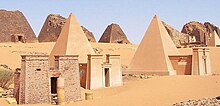
Following the conquest of North Africa's Mediterranean coastline by the Roman Empire, the area was integrated economically and culturally into the Roman system. Roman settlement occurred in modern Tunisia and elsewhere along the coast. The first Roman emperor native to North Africa was Septimius Severus, born in Leptis Magna in present-day Libya – his mother was Italian Roman and his father was Punic.[83]
Christianity spread across these areas at an early date, from Judaea via Egypt and beyond the borders of the Roman world into Nubia;[84] by 340 AD at the latest, it had become the state religion of the Aksumite Empire. Syro-Greek missionaries, who arrived by way of the Red Sea, were responsible for this theological development.[85]
In the early 7th century, the newly formed Arabian Islamic Caliphate expanded into Egypt, and then into North Africa. In a short while, the local Berber elite had been integrated into Muslim Arab tribes. When the Umayyad capital Damascus fell in the 8th century, the Islamic centre of the Mediterranean shifted from Syria to Qayrawan in North Africa. Islamic North Africa had become diverse, and a hub for mystics, scholars, jurists, and philosophers. During the above-mentioned period, Islam spread to sub-Saharan Africa, mainly through trade routes and migration.[86]
In West Africa, Dhar Tichitt and Oualata in present-day Mauritania figure prominently among the early urban centers, dated to 2,000 BC. About 500 stone settlements litter the region in the former savannah of the Sahara. Its inhabitants fished and grew millet. It has been found by Augustin Holl that the Soninke of the Mandé peoples were likely responsible for constructing such settlements. Around 300 BCE, the region became more desiccated and the settlements began to decline, most likely relocating to Koumbi Saleh.[87] Architectural evidence and the comparison of pottery styles suggest that Dhar Tichitt was related to the subsequent Ghana Empire. Djenné-Djenno (in present-day Mali) was settled around 300 BC, and the town grew to house a sizable Iron Age population, as evidenced by crowded cemeteries. Living structures were made of sun-dried mud. By 250 BCE, Djenné-Djenno had become a large, thriving market town.[88][89]
Further south, in central Nigeria, around 1,500 BC, the Nok culture developed on the Jos Plateau. It was a highly centralized community. The Nok people produced lifelike representations in terracotta, including human heads and human figures, elephants, and other animals. By 500 BC, and possibly earlier, they were smelting iron. By 200 AD, the Nok culture had vanished.[71] and vanished under unknown circumstances around 500 AD, having lasted approximately 2,000 years. Based on stylistic similarities with the Nok terracottas, the bronze figurines of the Yoruba kingdom of Ife and those of the Bini kingdom of Benin are suggested to be continuations of the traditions of the earlier Nok culture.[90][72]
Ninth to eighteenth centuries

Pre-colonial Africa possessed perhaps as many as 10,000 different states and polities[92] characterized by many different sorts of political organization and rule. These included small family groups of hunter-gatherers such as the San people of southern Africa; larger, more structured groups such as the family clan groupings of the Bantu-speaking peoples of central, southern, and eastern Africa; heavily structured clan groups in the Horn of Africa; the large Sahelian kingdoms; and autonomous city-states and kingdoms such as those of the Akan; Edo, Yoruba, and Igbo people in West Africa; and the Swahili coastal trading towns of Southeast Africa.
By the ninth century AD, a string of dynastic states, including the earliest Hausa states, stretched across the sub-Saharan savannah from the western regions to central Sudan. The most powerful of these states were Ghana, Gao, and the Kanem-Bornu Empire. Ghana declined in the eleventh century, but was succeeded by the Mali Empire which consolidated much of western Sudan in the thirteenth century. Kanem accepted Islam in the eleventh century.
In the forested regions of the West African coast, independent kingdoms grew with little influence from the Muslim north. The Kingdom of Nri was established around the ninth century and was one of the first. It is also one of the oldest kingdoms in present-day Nigeria and was ruled by the Eze Nri. The Nri kingdom is famous for its elaborate bronzes, found at the town of Igbo-Ukwu. The bronzes have been dated from as far back as the ninth century.[93]
The Kingdom of Ife, historically the first of these Yoruba city-states or kingdoms, established government under a priestly oba ('king' or 'ruler' in the Yoruba language), called the Ooni of Ife. Ife was noted as a major religious and cultural centre in West Africa, and for its unique naturalistic tradition of bronze sculpture. The Ife model of government was adapted at the Oyo Empire, where its obas or kings, called the Alaafins of Oyo, once controlled a large number of other Yoruba and non-Yoruba city-states and kingdoms; the Fon Kingdom of Dahomey was one of the non-Yoruba domains under Oyo control.

The Almoravids were a Berber dynasty from the Sahara that spread over a wide area of northwestern Africa and the Iberian peninsula during the eleventh century.[94] The Banu Hilal and Banu Ma'qil were a collection of Arab Bedouin tribes from the Arabian Peninsula who migrated westwards via Egypt between the eleventh and thirteenth centuries. Their migration resulted in the fusion of the Arabs and Berbers, where the locals were Arabized,[95] and Arab culture absorbed elements of the local culture, under the unifying framework of Islam.[96]
Following the breakup of Mali, a local leader named Sonni Ali (1464–1492) founded the Songhai Empire in the region of middle Niger and the western Sudan and took control of the trans-Saharan trade. Sonni Ali seized Timbuktu in 1468 and Jenne in 1473, building his regime on trade revenues and the cooperation of Muslim merchants. His successor Askia Mohammad I (1493–1528) made Islam the official religion, built mosques, and brought to Gao Muslim scholars, including al-Maghili (d.1504), the founder of an important tradition of Sudanic African Muslim scholarship.[97] By the eleventh century, some Hausa states – such as Kano, jigawa, Katsina, and Gobir – had developed into walled towns engaging in trade, servicing caravans, and the manufacture of goods. Until the fifteenth century, these small states were on the periphery of the major Sudanic empires of the era, paying tribute to Songhai to the west and Kanem-Borno to the east.
Height of the slave trade

Slavery had long been practiced in Africa.[98][99] Between the 15th and the 19th centuries, the Atlantic slave trade took an estimated 7–12 million slaves to the New World.[100][101][102] In addition, more than 1 million Europeans were captured by Barbary pirates and sold as slaves in North Africa between the 16th and 19th centuries.[103]
In West Africa, the decline of the Atlantic slave trade in the 1820s caused dramatic economic shifts in local polities. The gradual decline of slave-trading, prompted by a lack of demand for slaves in the New World, increasing anti-slavery legislation in Europe and America, and the British Royal Navy's increasing presence off the West African coast, obliged African states to adopt new economies. Between 1808 and 1860, the British West Africa Squadron seized approximately 1,600 slave ships and freed 150,000 Africans who were aboard.[104]
Action was also taken against African leaders who refused to agree to British treaties to outlaw the trade, for example against "the usurping King of Lagos", deposed in 1851. Anti-slavery treaties were signed with over 50 African rulers.[105] The largest powers of West Africa (the Asante Confederacy, the Kingdom of Dahomey, and the Oyo Empire) adopted different ways of adapting to the shift. Asante and Dahomey concentrated on the development of "legitimate commerce" in the form of palm oil, cocoa, timber and gold, forming the bedrock of West Africa's modern export trade. The Oyo Empire, unable to adapt, collapsed into civil wars.[106]
Colonialism
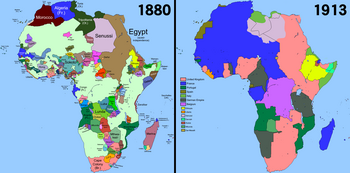
The Scramble for Africa,[b] as used by historians, describes the invasion, annexation, division, and colonization of most of Africa by seven Western European powers during an era known as "New Imperialism" (between 1833 and 1914). The 10 percent of Africa that was under formal European control in 1870 increased to almost 90 percent by 1914, with only Liberia and Ethiopia remaining independent (although Ethiopia was later invaded and conquered by Italy in the 1930s).[c]
The Berlin Conference of 1884, which regulated European colonization and trade in Africa, is seen as emblematic of the "scramble".[108] In the last quarter of the 19th century, there were considerable political rivalries between the European empires, which provided the impetus for the Scramble.[109] The later years of the 19th century saw a transition from "informal imperialism" – military influence and economic dominance – to direct rule.[110]
Most of Africa was decolonised during the Cold War period. However, the old imperial boundaries and economic systems imposed by the Scramble still affect the politics and economy of African nations today.[111]Independence struggles

Imperial rule by Europeans would continue until after the conclusion of World War II, when almost all remaining colonial territories gradually obtained formal independence. Independence movements in Africa gained momentum following World War II, which left the major European powers weakened. In 1951, Libya, a former Italian colony, gained independence. In 1956, Tunisia and Morocco won their independence from France.[112] Ghana followed suit the next year (March 1957),[113] becoming the first of the sub-Saharan colonies to be granted independence. Most of the rest of the continent became independent over the next decade.
Portugal's overseas presence in sub-Saharan Africa (most notably in Angola, Cape Verde, Mozambique, Guinea-Bissau, and São Tomé and Príncipe) lasted from the 16th century to 1975, after the Estado Novo regime was overthrown in a military coup in Lisbon. Rhodesia unilaterally declared independence from the United Kingdom in 1965, under the white minority government of Ian Smith, but was not internationally recognized as an independent state (as Zimbabwe) until 1980, when black nationalists gained power after a bitter guerrilla war. Although South Africa was one of the first African countries to gain independence, the state remained under the control of the country's white minority, initially through qualified voting rights and from 1956 by a system of racial segregation known as apartheid, until 1994.
Post-colonial Africa
Today, Africa contains 54 sovereign countries, most of which have borders that were drawn during the era of European colonialism. Since independence, African states have frequently been hampered by instability, corruption, violence, and authoritarianism. The vast majority of African states are republics that operate under some form of the presidential system of rule. However, few of them have been able to sustain democratic governments on a permanent basis – per the criteria laid out by Lührmann et al. (2018), only Botswana and Mauritius have been consistently democratic for the entirety of their post-colonial history. Most African countries have experienced several coups or periods of military dictatorship. Between 1990 and 2018, though, the continent as a whole has trended towards more democratic governance.[114]
Upon independence an overwhelming majority of Africans lived in extreme poverty. The continent suffered from the lack of infrastructural or industrial development under colonial rule, along with political instability. With limited financial resources or access to global markets, relatively stable countries such as Kenya still experienced only very slow economic development. Only a handful of African countries succeeded in obtaining rapid economic growth prior to 1990. Exceptions include Libya and Equatorial Guinea, both of which possess large oil reserves.
Instability throughout the continent after decolonization resulted primarily from marginalization of ethnic groups, and corruption. In pursuit of personal political gain, many leaders deliberately promoted ethnic conflicts, some of which had originated during the colonial period, such as from the grouping of multiple unrelated ethnic groups into a single colony, the splitting of a distinct ethnic group between multiple colonies, or existing conflicts being exacerbated by colonial rule (for instance, the preferential treatment given to ethnic Hutus over Tutsis in Rwanda during German and Belgian rule).
Faced with increasingly frequent and severe violence, military rule was widely accepted by the population of many countries as means to maintain order, and during the 1970s and 1980s a majority of African countries were controlled by military dictatorships. Territorial disputes between nations and rebellions by groups seeking independence were also common in independent African states. The most devastating of these was the Nigerian Civil War, fought between government forces and an Igbo separatist republic, which resulted in a famine that killed 1–2 million people. Two civil wars in Sudan, the first lasting from 1955 to 1972 and the second from 1983 to 2005, collectively killed around 3 million. Both were fought primarily on ethnic and religious lines.
Cold War conflicts between the United States and the Soviet Union also contributed to instability. Both the Soviet Union and the United States offered considerable incentives to African political and military leaders who aligned themselves with the superpowers' foreign policy. As an example, during the Angolan Civil War, the Soviet and Cuban aligned MPLA and the American aligned UNITA received the vast majority of their military and political support from these countries. Many African countries became highly dependent on foreign aid. The sudden loss of both Soviet and American aid at the end of the Cold War and fall of the USSR resulted in severe economic and political turmoil in the countries most dependent on foreign support.
There was a major famine in Ethiopia between 1983 and 1985, killing up to 1.2 million people, which most historians attribute primarily to the forced relocation of farmworkers and seizure of grain by communist Derg government, further exacerbated by the civil war.[115][116][117][118] In 1994 a genocide in Rwanda resulted in up to 800,000 deaths, added to a severe refugee crisis and fueled the rise of militia groups in neighboring countries. This contributed to the outbreak of the first and second Congo Wars, which were the most devastating military conflicts in modern Africa, with up to 5.5 million deaths,[119] making it by far the deadliest conflict in modern African history and one of the costliest wars in human history.[120]
-
An animated map shows the order of independence of African nations, 1950–2011
-
Africa's wars and conflicts, 1980–96Major Wars/Conflict (>100,000 casualties)Minor Wars/ConflictOther Conflicts
-
Political map of Africa in 2021
Various conflicts between various insurgent groups and governments continue. Since 2003 there has been an ongoing conflict in Darfur (Sudan) which peaked in intensity from 2003 to 2005 with notable spikes in violence in 2007 and 2013–15, killing around 300,000 people total. The Boko Haram Insurgency primarily within Nigeria (with considerable fighting in Niger, Chad, and Cameroon as well) has killed around 350,000 people since 2009. Most African conflicts have been reduced to low-intensity conflicts as of 2022. However, the Tigray War which began in 2020 has killed an estimated 300,000–500,000 people, primarily due to famine.
Overall though, violence across Africa has greatly declined in the 21st century, with the end of civil wars in Angola, Sierra Leone, and Algeria in 2002, Liberia in 2003, and Sudan and Burundi in 2005. The Second Congo War, which involved 9 countries and several insurgent groups, ended in 2003. This decline in violence coincided with many countries abandoning communist-style command economies and opening up for market reforms, which over the course of the 1990s and 2000s promoted the establishment of permanent, peaceful trade between neighboring countries (see Capitalist peace).
Improved stability and economic reforms have led to a great increase in foreign investment into many African nations, mainly from China,[121] which further spurred economic growth. Between 2000 and 2014, annual GDP growth in sub-Saharan Africa averaged 5.02%, doubling its total GDP from $811 Billion to $1.63 Trillion (Constant 2015 USD).[122] North Africa experienced comparable growth rates.[123] A significant part of this growth can also be attributed to the facilitated diffusion of information technologies and specifically the mobile telephone.[124] While several individual countries have maintained high growth rates, since 2014 overall growth has considerably slowed, primarily as a result of falling commodity prices, continued lack of industrialization, and epidemics of Ebola and COVID-19.[125][126]
Geology, geography, ecology, and environment

Africa is the largest of the three great southward projections from the largest landmass of the Earth. Separated from Europe by the Mediterranean Sea, it is joined to Asia at its northeast extremity by the Isthmus of Suez (transected by the Suez Canal), 163 km (101 mi) wide.[127] (Geopolitically, Egypt's Sinai Peninsula east of the Suez Canal is often considered part of Africa, as well.)[128]
The coastline is 26,000 km (16,000 mi) long, and the absence of deep indentations of the shore is illustrated by the fact that Europe, which covers only 10,400,000 km2 (4,000,000 sq mi) – about a third of the surface of Africa – has a coastline of 32,000 km (20,000 mi).[129] From the most northerly point, Ras ben Sakka in Tunisia (37°21' N), to the most southerly point, Cape Agulhas in South Africa (34°51'15" S), is a distance of approximately 8,000 km (5,000 mi).[130] Cape Verde, 17°33'22" W, the westernmost point, is a distance of approximately 7,400 km (4,600 mi) to Ras Hafun, 51°27'52" E, the most easterly projection that neighbours Cape Guardafui, the tip of the Horn of Africa.[129]
Africa's largest country is Algeria, and its smallest country is Seychelles, an archipelago off the east coast.[131] The smallest nation on the continental mainland is The Gambia.
African plate

The African Plate, also known as the Nubian Plate, is a major tectonic plate that includes much of the continent of Africa (except for its easternmost part) and the adjacent oceanic crust to the west and south. It is bounded by the North American Plate and South American Plate to the west (separated by the Mid-Atlantic Ridge); the Arabian Plate and Somali Plate to the east; the Eurasian Plate, Aegean Sea Plate and Anatolian Plate to the north; and the Antarctic Plate to the south.
Between 60 million years ago and 10 million years ago, the Somali Plate began rifting from the African Plate along the East African Rift.[132] Since the continent of Africa consists of crust from both the African and the Somali plates, some literature refers to the African Plate as the Nubian Plate to distinguish it from the continent as a whole.[133]Climate
The climate of Africa ranges from tropical to subarctic on its highest peaks. Its northern half is primarily desert, or arid, while its central and southern areas contain both savanna plains and dense jungle (rainforest) regions. In between, there is a convergence, where vegetation patterns such as sahel and steppe dominate. Africa is the hottest continent on Earth and 60% of the entire land surface consists of drylands and deserts.[134] The record for the highest-ever recorded temperature, in Libya in 1922 (58 °C (136 °F)), was discredited in 2013.[135][136]
Climate change

Climate change in Africa is an increasingly serious threat as Africa is among the most vulnerable continents to the effects of climate change.[137][138][139] Some sources even classify Africa as "the most vulnerable continent on Earth".[140][141] This vulnerability is driven by a range of factors that include weak adaptive capacity, high dependence on ecosystem goods for livelihoods, and less developed agricultural production systems.[142] The risks of climate change on agricultural production, food security, water resources and ecosystem services will likely have increasingly severe consequences on lives and sustainable development prospects in Africa.[138] With high confidence, it was projected by the IPCC in 2007 that in many African countries and regions, agricultural production and food security would probably be severely compromised by climate change and climate variability.[143] Managing this risk requires an integration of mitigation and adaptation strategies in the management of ecosystem goods and services, and the agriculture production systems in Africa.[144]
Over the coming decades, warming from climate change is expected across almost all the Earth's surface, and global mean rainfall will increase.[145] Currently, Africa is warming faster than the rest of the world on average. Large portions of the continent may become uninhabitable as a result of the rapid effects of climate change, which would have disastrous effects on human health, food security, and poverty.[146][147][148] Regional effects on rainfall in the tropics are expected to be much more spatially variable and the sign of change at any one location is often less certain, although changes are expected. Consistent with this, observed surface temperatures have generally increased over Africa since the late 19th century to the early 21st century by about 1 °C, but locally as much as 3 °C for minimum temperature in the Sahel at the end of the dry season.[149] Observed precipitation trends indicate spatial and temporal discrepancies as expected.[150][138] The observed changes in temperature and precipitation vary regionally.[151][150]Ecology and biodiversity

Africa has over 3,000 protected areas, with 198 marine protected areas, 50 biosphere reserves, and 80 wetlands reserves. Significant habitat destruction, increases in human population and poaching are reducing Africa's biological diversity and arable land. Human encroachment, civil unrest and the introduction of non-native species threaten biodiversity in Africa. This has been exacerbated by administrative problems, inadequate personnel and funding problems.[134]
Deforestation is affecting Africa at twice the world rate, according to the United Nations Environment Programme (UNEP).[152] According to the University of Pennsylvania African Studies Center, 31% of Africa's pasture lands and 19% of its forests and woodlands are classified as degraded, and Africa is losing over four million hectares of forest per year, which is twice the average deforestation rate for the rest of the world.[134] Some sources claim that approximately 90% of the original, virgin forests in West Africa have been destroyed.[153] Over 90% of Madagascar's original forests have been destroyed since the arrival of humans 2000 years ago.[154] About 65% of Africa's agricultural land suffers from soil degradation.[155]
Fauna

Africa boasts perhaps the world's largest combination of density and "range of freedom" of wild animal populations and diversity, with wild populations of large carnivores (such as lions, hyenas, and cheetahs) and herbivores (such as buffalo, elephants, camels, and giraffes) ranging freely on primarily open non-private plains. It is also home to a variety of "jungle" animals including snakes and primates and aquatic life such as crocodiles and amphibians. In addition, Africa has the largest number of megafauna species, as it was least affected by the extinction of the Pleistocene megafauna.
Environmental issues
Infrastructure
Water resources
Water development and management are complex in Africa due to the multiplicity of trans-boundary water resources (rivers, lakes and aquifers).[158] Around 75% of sub-Saharan Africa falls within 53 international river basin catchments that traverse multiple borders.[159][158] This particular constraint can also be converted into an opportunity if the potential for trans-boundary cooperation is harnessed in the development of the area's water resources.[158] A multi-sectoral analysis of the Zambezi River, for example, shows that riparian cooperation could lead to a 23% increase in firm energy production without any additional investments.[159][158] A number of institutional and legal frameworks for transboundary cooperation exist, such as the Zambezi River Authority, the Southern African Development Community (SADC) Protocol, Volta River Authority and the Nile Basin Commission.[158] However, additional efforts are required to further develop political will, as well as the financial capacities and institutional frameworks needed for win-win multilateral cooperative actions and optimal solutions for all riparians.[158]
Politics
African Union
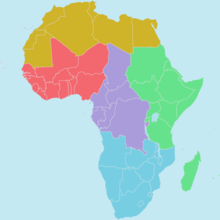
Northern Region , Southern Region , Eastern Region , Western Regions A and B , Central Region
The African Union (AU) is a continental union consisting of 55 member states. The union was formed, with Addis Ababa, Ethiopia, as its headquarters, on 26 June 2001. The union was officially established on 9 July 2002[160] as a successor to the Organisation of African Unity (OAU). In July 2004, the African Union's Pan-African Parliament (PAP) was relocated to Midrand, in South Africa, but the African Commission on Human and Peoples' Rights remained in Addis Ababa.
The African Union, not to be confused with the AU Commission, is formed by the Constitutive Act of the African Union, which aims to transform the African Economic Community, a federated commonwealth, into a state under established international conventions. The African Union has a parliamentary government, known as the African Union Government, consisting of legislative, judicial and executive organs. It is led by the African Union President and Head of State, who is also the President of the Pan-African Parliament. A person becomes AU President by being elected to the PAP, and subsequently gaining majority support in the PAP. The powers and authority of the President of the African Parliament derive from the Constitutive Act and the Protocol of the Pan-African Parliament, as well as the inheritance of presidential authority stipulated by African treaties and by international treaties, including those subordinating the Secretary General of the OAU Secretariat (AU Commission) to the PAP. The government of the AU consists of all-union, regional, state, and municipal authorities, as well as hundreds of institutions, that together manage the day-to-day affairs of the institution.
Extensive human rights abuses still occur in several parts of Africa, often under the oversight of the state. Most of such violations occur for political reasons, often as a side effect of civil war. Countries where major human rights violations have been reported in recent times include the Democratic Republic of the Congo, Sierra Leone, Liberia, Sudan, Zimbabwe, and Ivory Coast.
Boundary conflicts
Economy

Although it has abundant natural resources, Africa remains the world's poorest and least-developed continent (other than Antarctica), the result of a variety of causes that may include corrupt governments that have often committed serious human rights violations, failed central planning, high levels of illiteracy, low self-esteem, lack of access to foreign capital, legacies of colonialism, the slave trade, and the Cold War, and frequent tribal and military conflict (ranging from guerrilla warfare to genocide).[164] Its total nominal GDP remains behind that of the United States, China, Japan, Germany, the United Kingdom, India and France. According to the United Nations' Human Development Report in 2003, the bottom 24 ranked nations (151st to 175th) were all African.[165]
Poverty, illiteracy, malnutrition and inadequate water supply and sanitation, as well as poor health, affect a large proportion of the people who reside in the African continent. In August 2008, the World Bank[166] announced revised global poverty estimates based on a new international poverty line of $1.25 per day (versus the previous measure of $1.00). Eighty-one percent of the sub-Saharan African population was living on less than $2.50 (PPP) per day in 2005, compared with 86% for India.[167]
Sub-Saharan Africa is the least successful region of the world in reducing poverty ($1.25 per day); some 50% of the population living in poverty in 1981 (200 million people), a figure that rose to 58% in 1996 before dropping to 50% in 2005 (380 million people). The average poor person in sub-Saharan Africa is estimated to live on only 70 cents per day, and was poorer in 2003 than in 1973,[168] indicating increasing poverty in some areas. Some of it is attributed to unsuccessful economic liberalization programmes spearheaded by foreign companies and governments, but other studies have cited bad domestic government policies more than external factors.[169][170]
Africa is now at risk of being in debt once again, particularly in sub-Saharan African countries. The last debt crisis in 2005 was resolved with help from the heavily indebted poor countries scheme (HIPC). The HIPC resulted in some positive and negative effects on the economy in Africa. About ten years after the 2005 debt crisis in sub-Saharan Africa was resolved, Zambia fell back into debt. A small reason was due to the fall in copper prices in 2011, but the bigger reason was that a large amount of the money Zambia borrowed was wasted or pocketed by the elite.[171]
From 1995 to 2005, Africa's rate of economic growth increased, averaging 5% in 2005. Some countries experienced still higher growth rates, notably Angola, Sudan and Equatorial Guinea, all of which had recently begun extracting their petroleum reserves or had expanded their oil extraction capacity.
In a recently published analysis based on World Values Survey data, the Austrian political scientist Arno Tausch maintained that several African countries, most notably Ghana, perform quite well on scales of mass support for democracy and the market economy.[172]
| Rank | Country | GDP (nominal, Peak Year) millions of USD |
Peak Year |
|---|---|---|---|
| — | 2,945,709 | 2022 | |
| 1 | 568,499 | 2014 | |
| 2 | 476,748 | 2022 | |
| 3 | 458,708 | 2011 | |
| 4 | 224,107 | 2023 | |
| 5 | 155,804 | 2023 | |
| 6 | 147,343 | 2023 | |
| 7 | 145,712 | 2014 | |
| 8 | 113,701 | 2022 | |
| 9 | 92,542 | 2012 | |
| 10 | 84,033 | 2023 |
| Rank | Country | GDP (PPP, Peak Year) millions of USD |
Peak Year |
|---|---|---|---|
| — | 8,865,179 | 2023 | |
| 1 | 1,809,425 | 2023 | |
| 2 | 1,365,903 | 2023 | |
| 3 | 997,444 | 2023 | |
| 4 | 628,990 | 2023 | |
| 5 | 393,297 | 2023 | |
| 6 | 385,337 | 2023 | |
| 7 | 338,964 | 2023 | |
| 8 | 260,323 | 2023 | |
| 9 | 227,725 | 2023 | |
| 10 | 227,189 | 2023 |
Tausch's global value comparison based on the World Values Survey derived the following factor analytical scales: 1. The non-violent and law-abiding society 2. Democracy movement 3. Climate of personal non-violence 4. Trust in institutions 5. Happiness, good health 6. No redistributive religious fundamentalism 7. Accepting the market 8. Feminism 9. Involvement in politics 10. Optimism and engagement 11. No welfare mentality, acceptancy of the Calvinist work ethics. The spread in the performance of African countries with complete data, Tausch concluded "is really amazing". While one should be especially hopeful about the development of future democracy and the market economy in Ghana, the article suggests pessimistic tendencies for Egypt and Algeria, and especially for Africa's leading economy, South Africa. High Human Inequality, as measured by the UNDP's Human Development Report's Index of Human Inequality, further impairs the development of human security. Tausch also maintains that the certain recent optimism, corresponding to economic and human rights data, emerging from Africa, is reflected in the development of a civil society.

The continent is believed to hold 90% of the world's cobalt, 90% of its platinum, 50% of its gold, 98% of its chromium, 70% of its tantalite,[174] 64% of its manganese and one-third of its uranium.[175] The Democratic Republic of the Congo (DRC) has 70% of the world's coltan, a mineral used in the production of tantalum capacitors for electronic devices such as cell phones. The DRC also has more than 30% of the world's diamond reserves.[176] Guinea is the world's largest exporter of bauxite.[177] As the growth in Africa has been driven mainly by services and not manufacturing or agriculture, it has been growth without jobs and without reduction in poverty levels. In fact, the food security crisis of 2008 which took place on the heels of the global financial crisis pushed 100 million people into food insecurity.[178]
In recent years, the People's Republic of China has built increasingly stronger ties with African nations and is Africa's largest trading partner. In 2007, Chinese companies invested a total of US$1 billion in Africa.[121]
A Harvard University study led by professor Calestous Juma showed that Africa could feed itself by making the transition from importer to self-sufficiency. "African agriculture is at the crossroads; we have come to the end of a century of policies that favoured Africa's export of raw materials and importation of food. Africa is starting to focus on agricultural innovation as its new engine for regional trade and prosperity."[179]
Electricity generation
The main source of electricity is hydropower, which contributes significantly to the current installed capacity for energy.[158] The Kainji Dam is a typical hydropower resource generating electricity for all the large cities in Nigeria as well as their neighbouring country, Niger.[180] Hence, the continuous investment in the last decade, which has increased the amount of power generated.[158]
Demographics
Proportion of total African population by country
>Text je dostupný pod licencí Creative Commons Uveďte autora – Zachovejte licenci, případně za dalších podmínek. Podrobnosti naleznete na stránce Podmínky užití.
Text je dostupný za podmienok Creative
Commons Attribution/Share-Alike License 3.0 Unported; prípadne za ďalších
podmienok.
Podrobnejšie informácie nájdete na stránke Podmienky
použitia.
